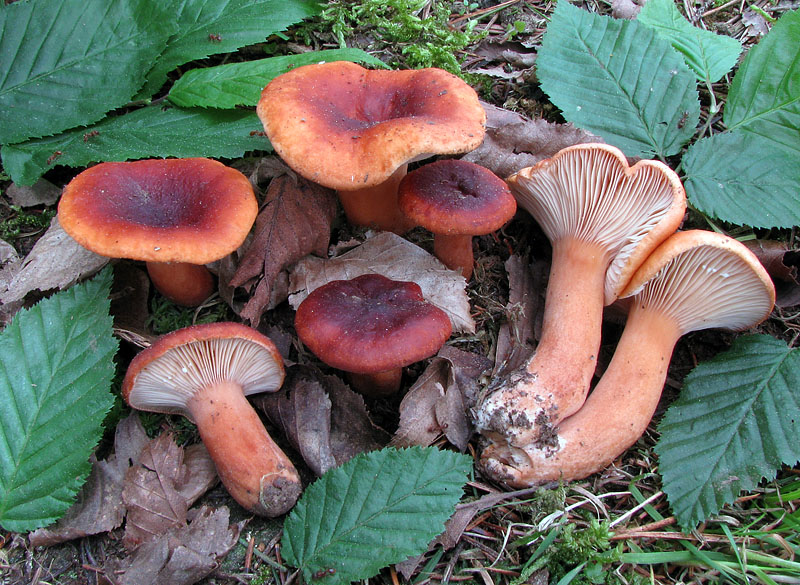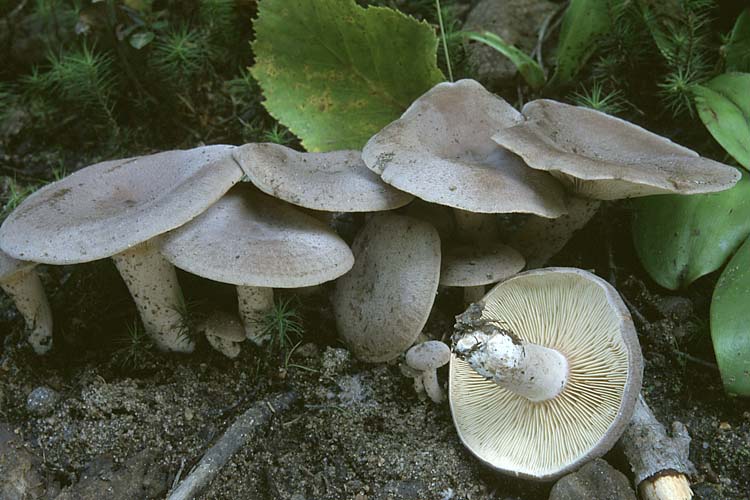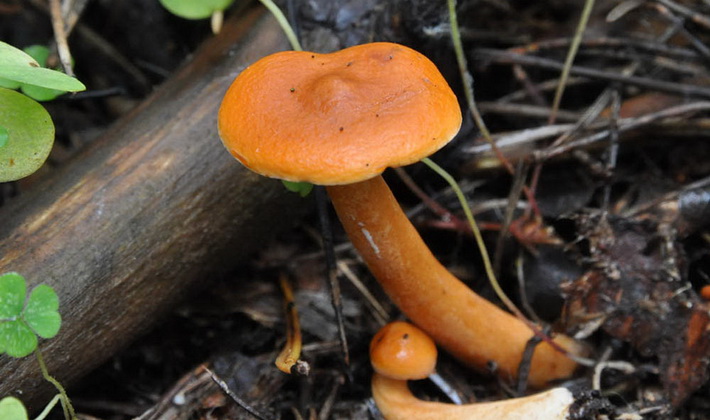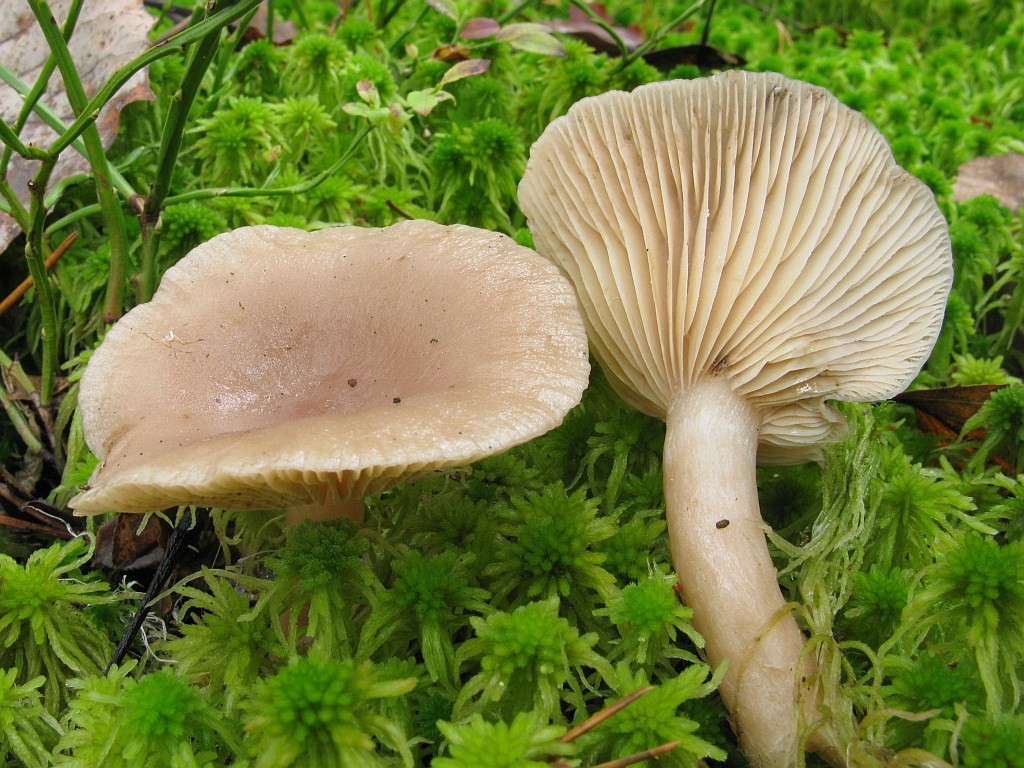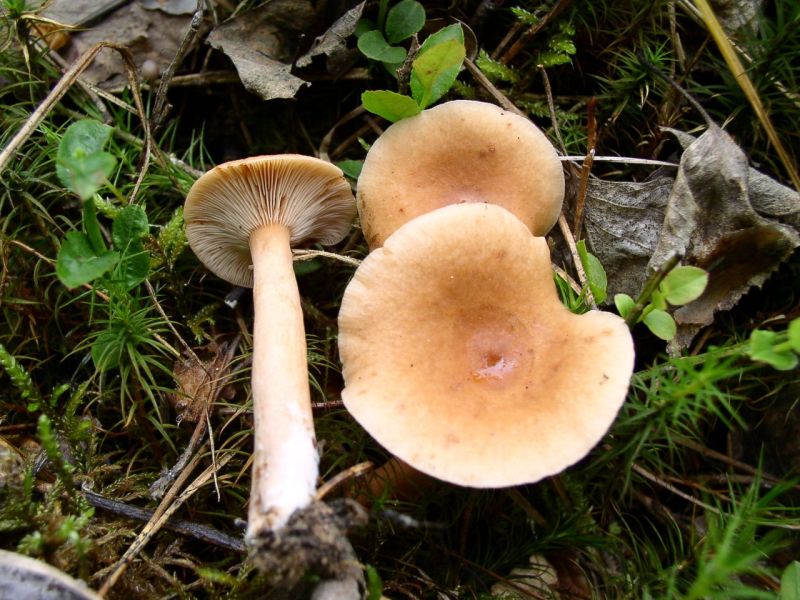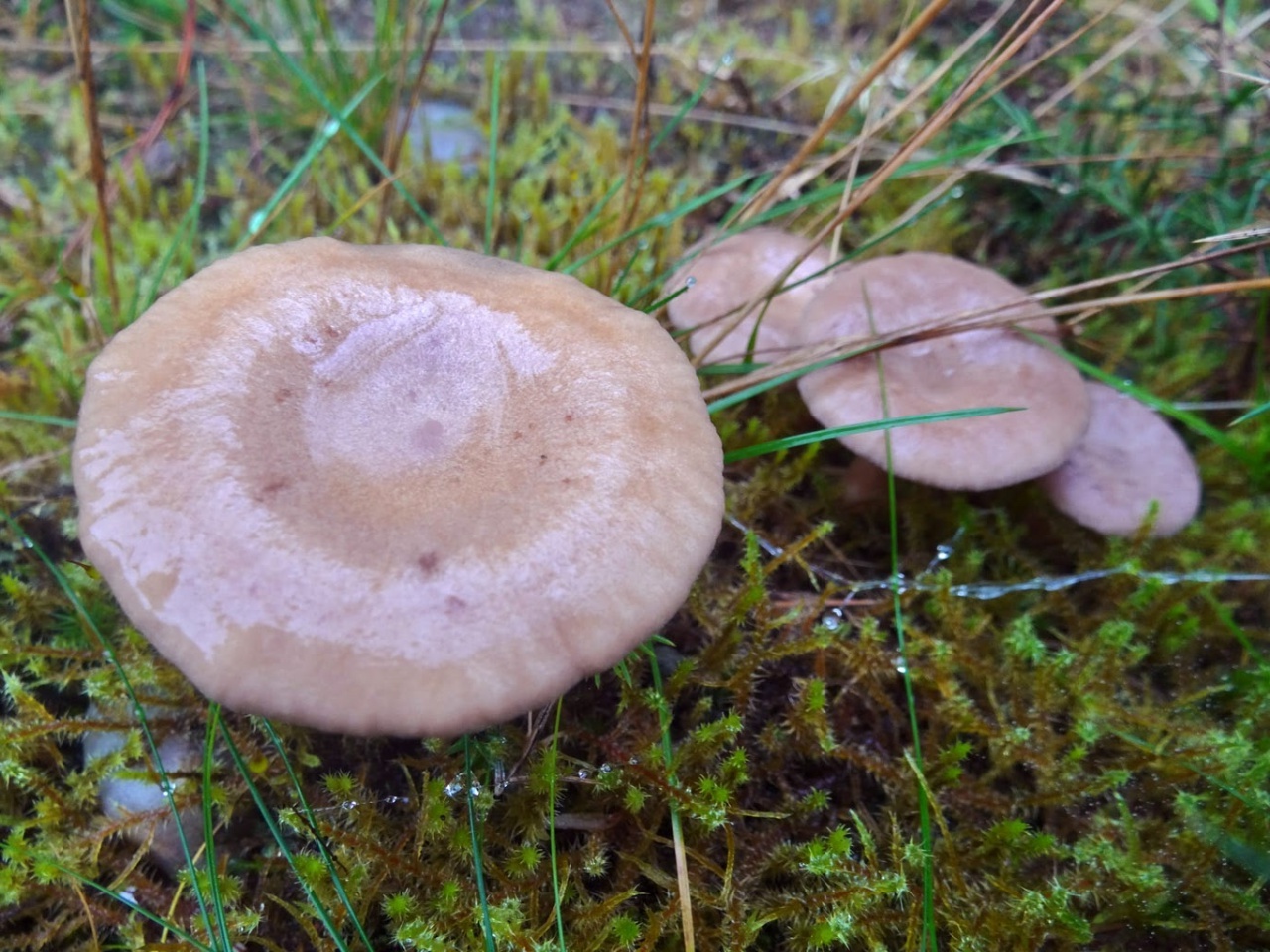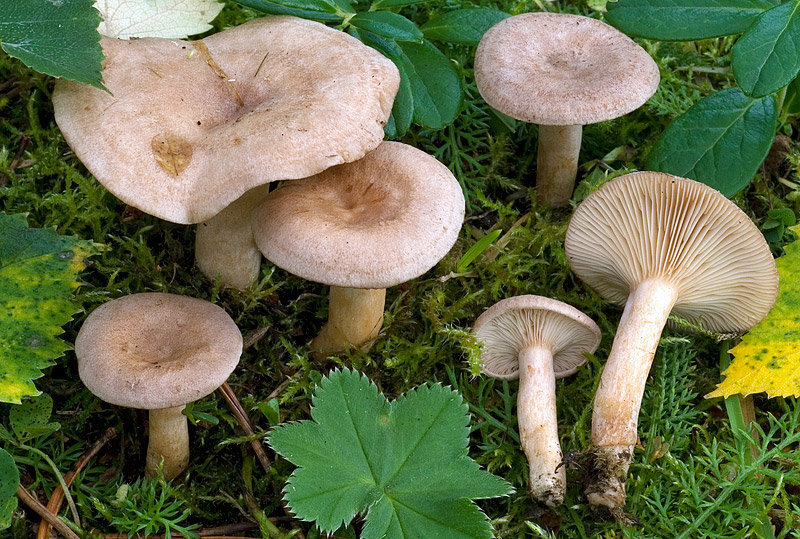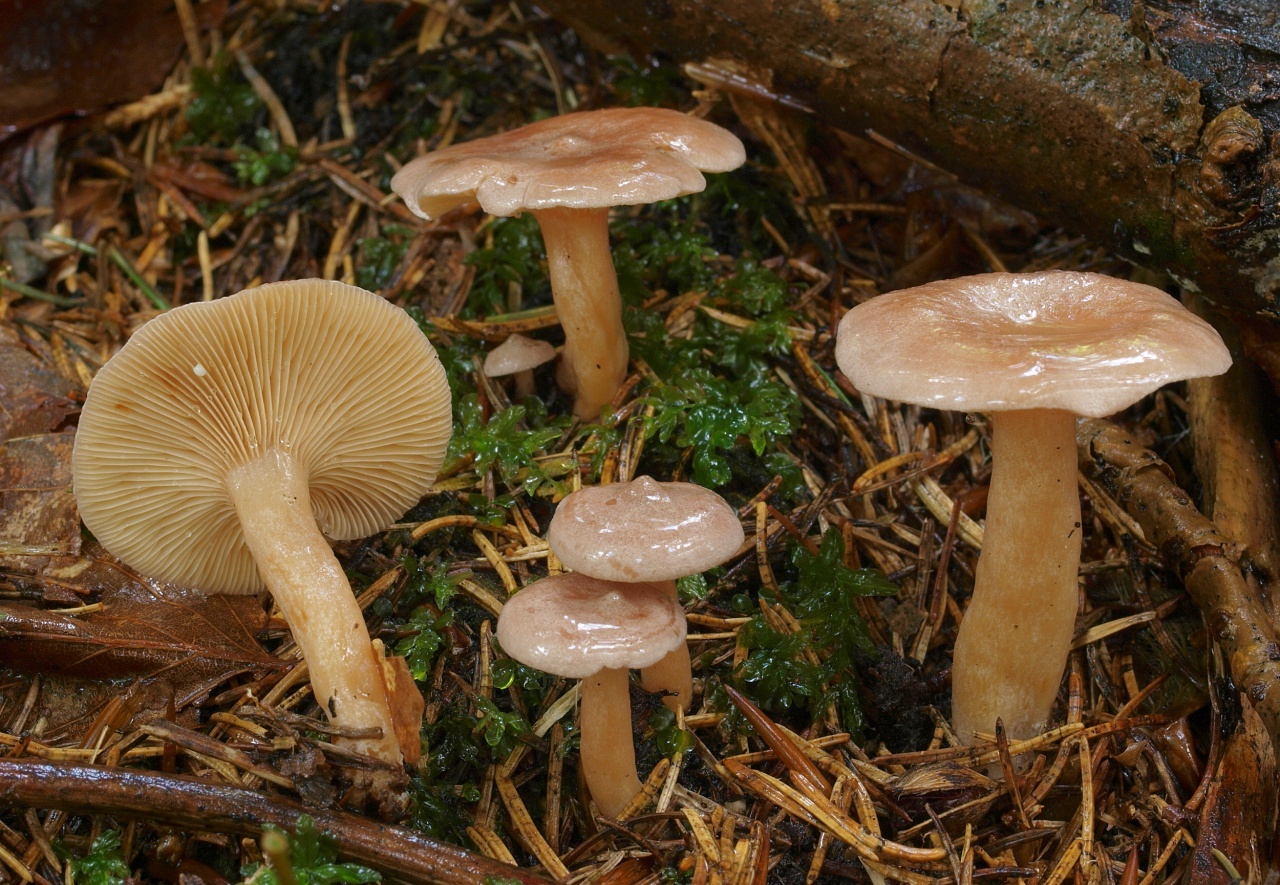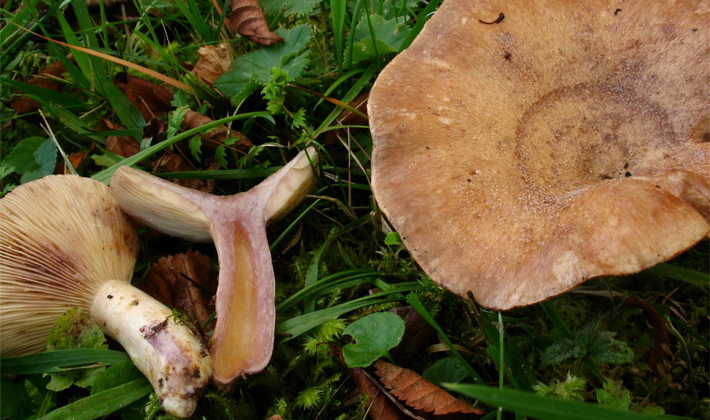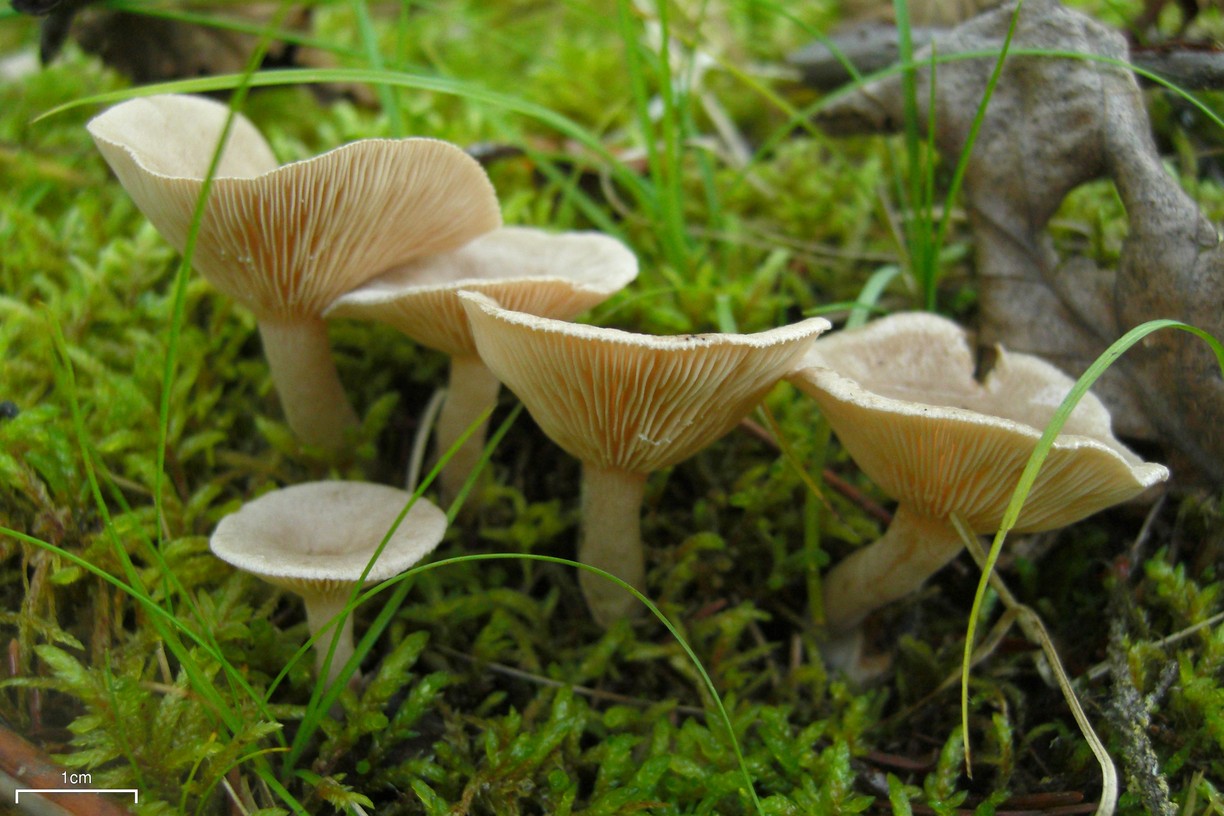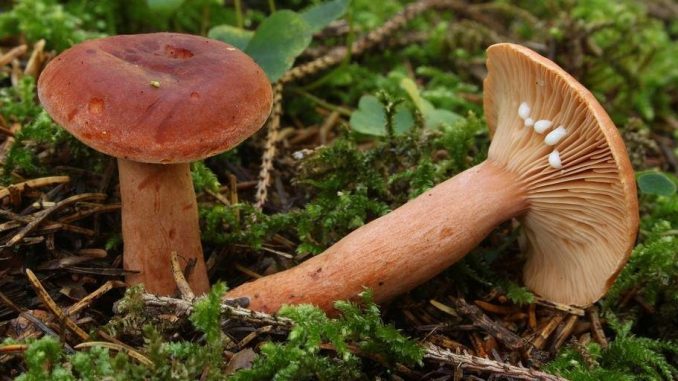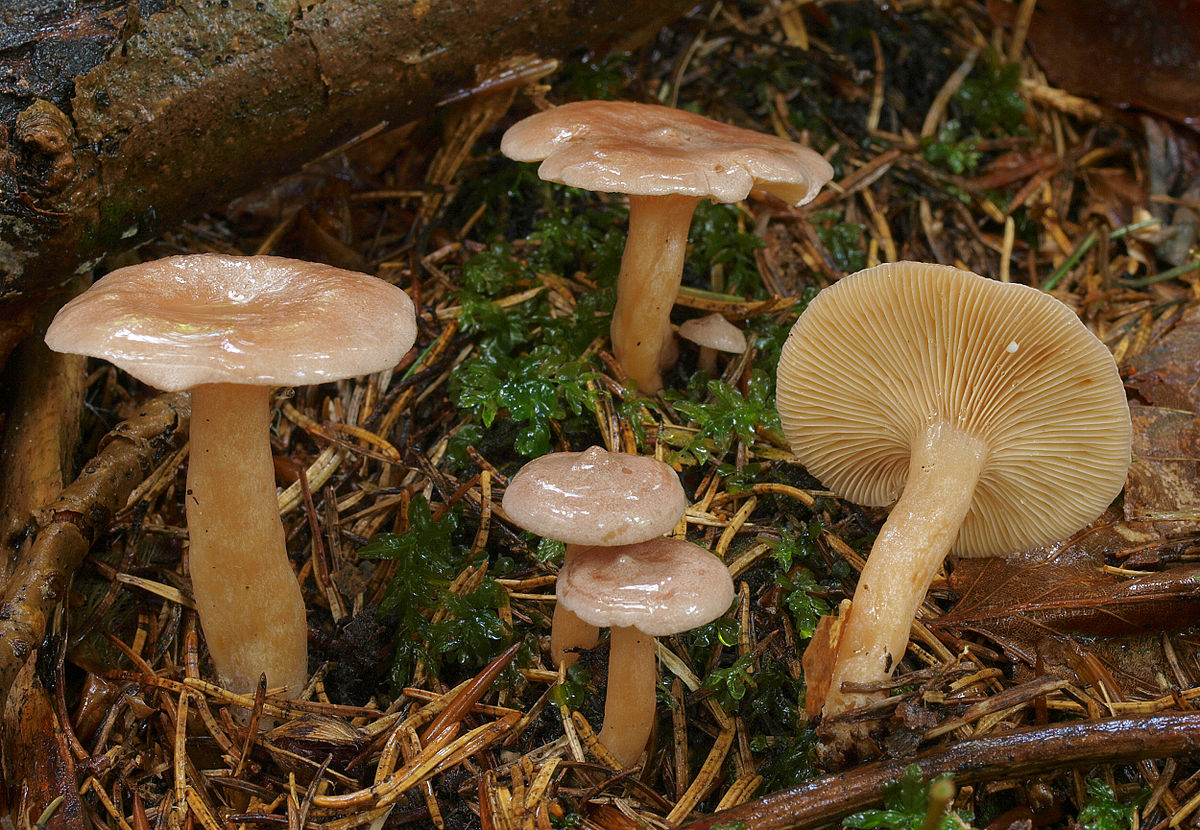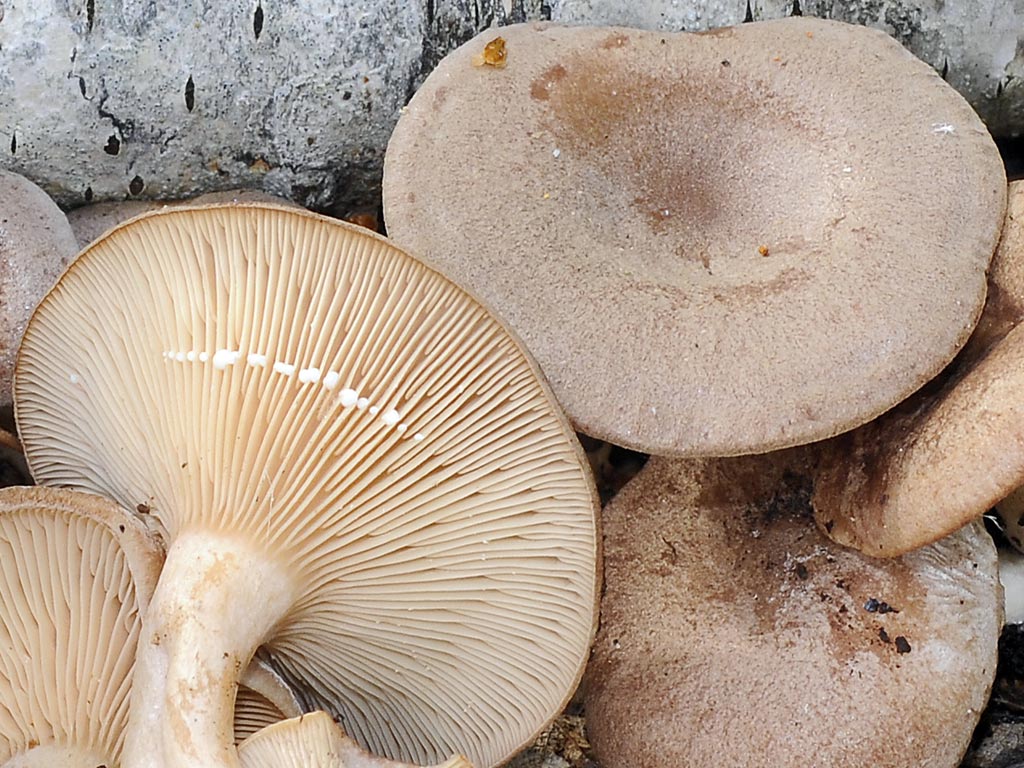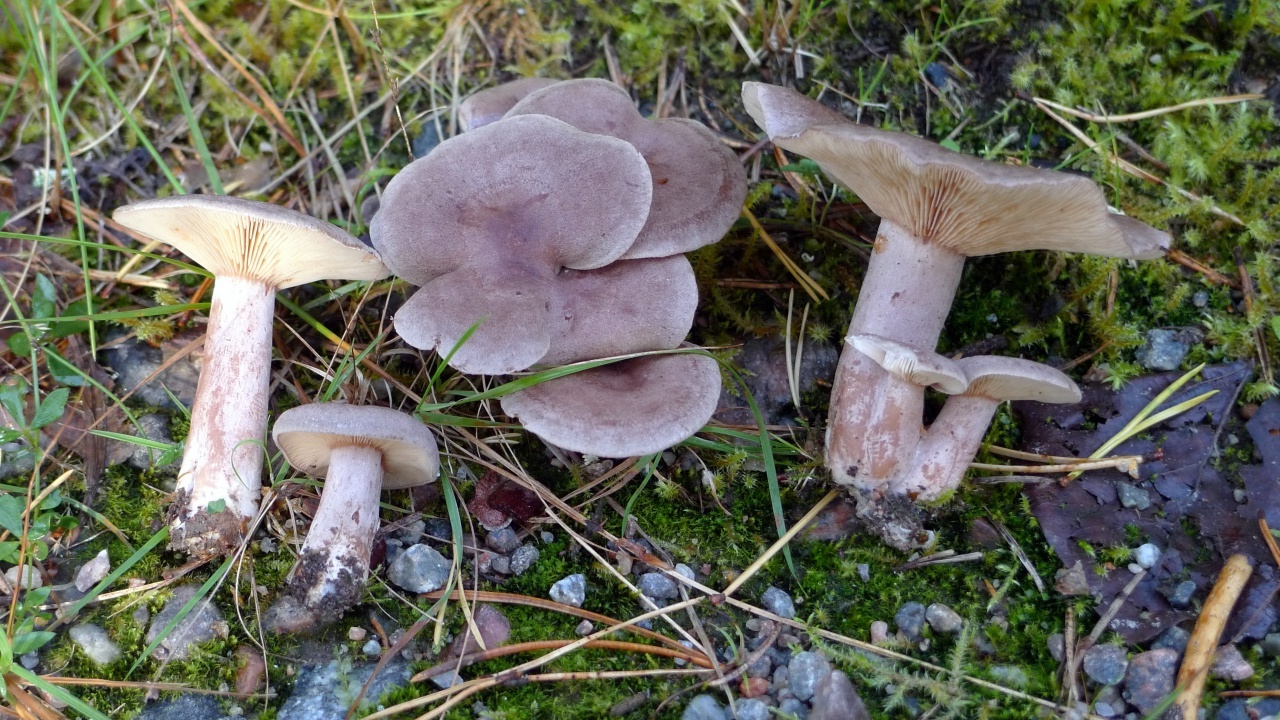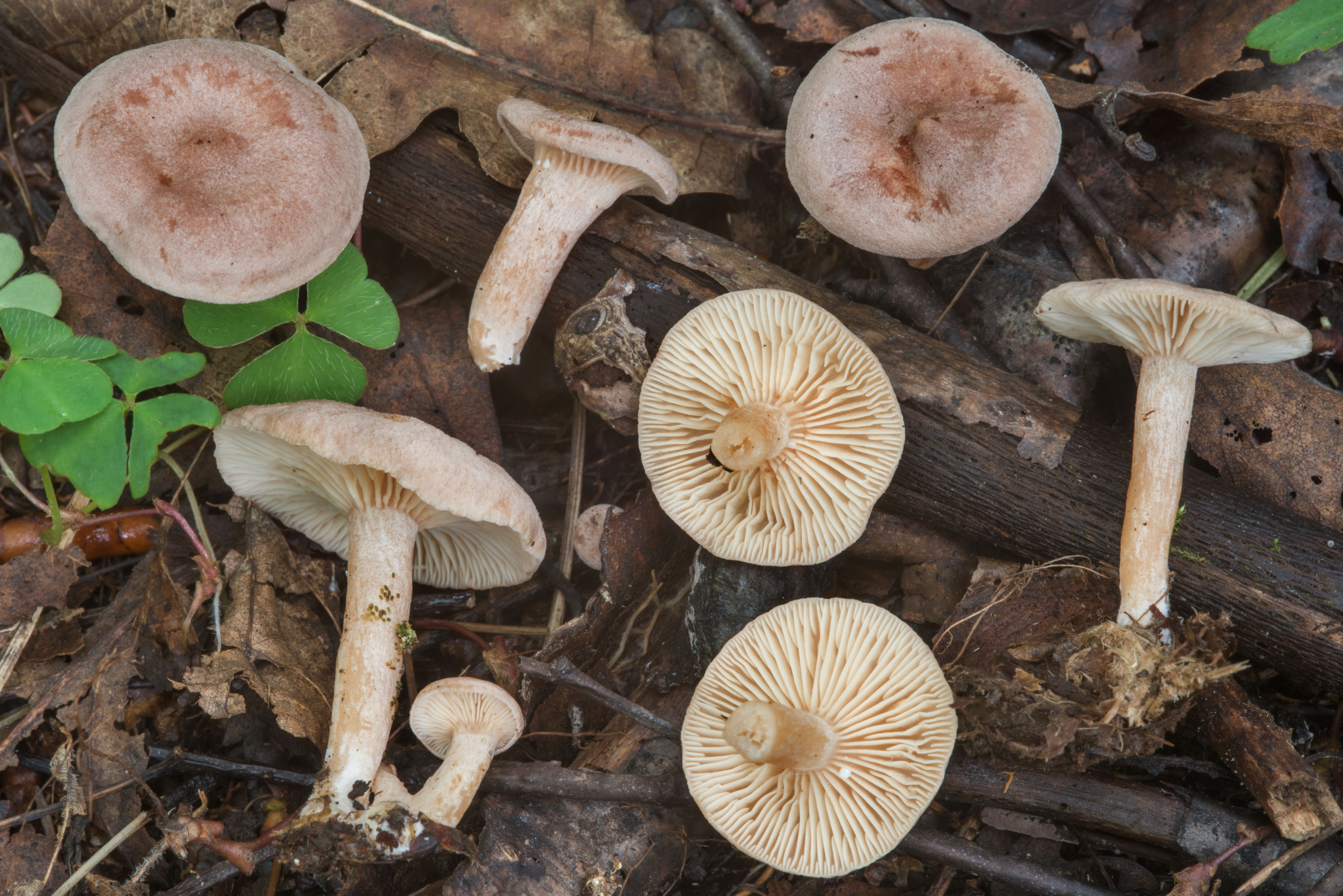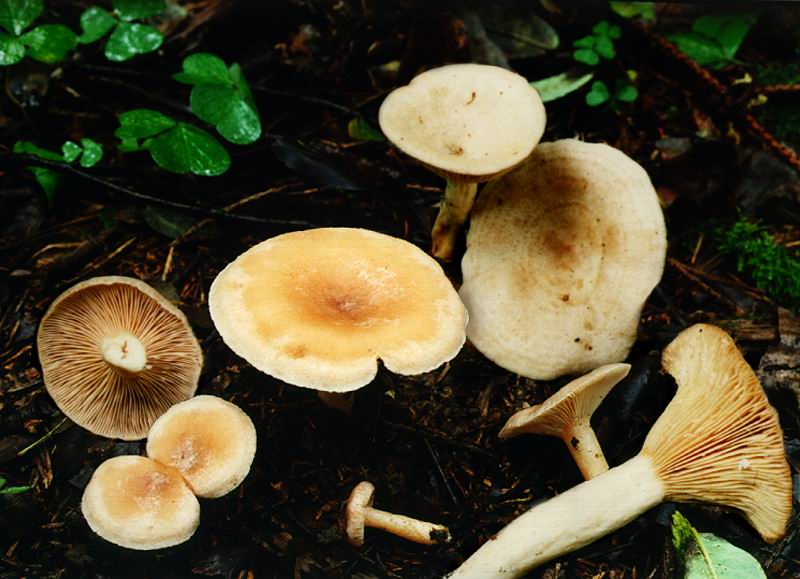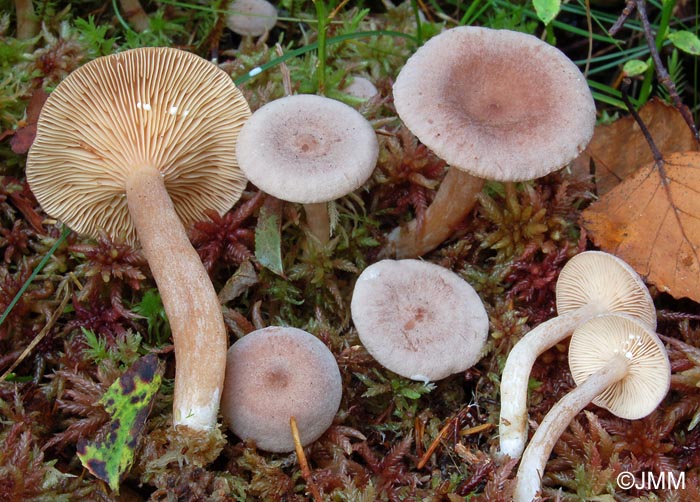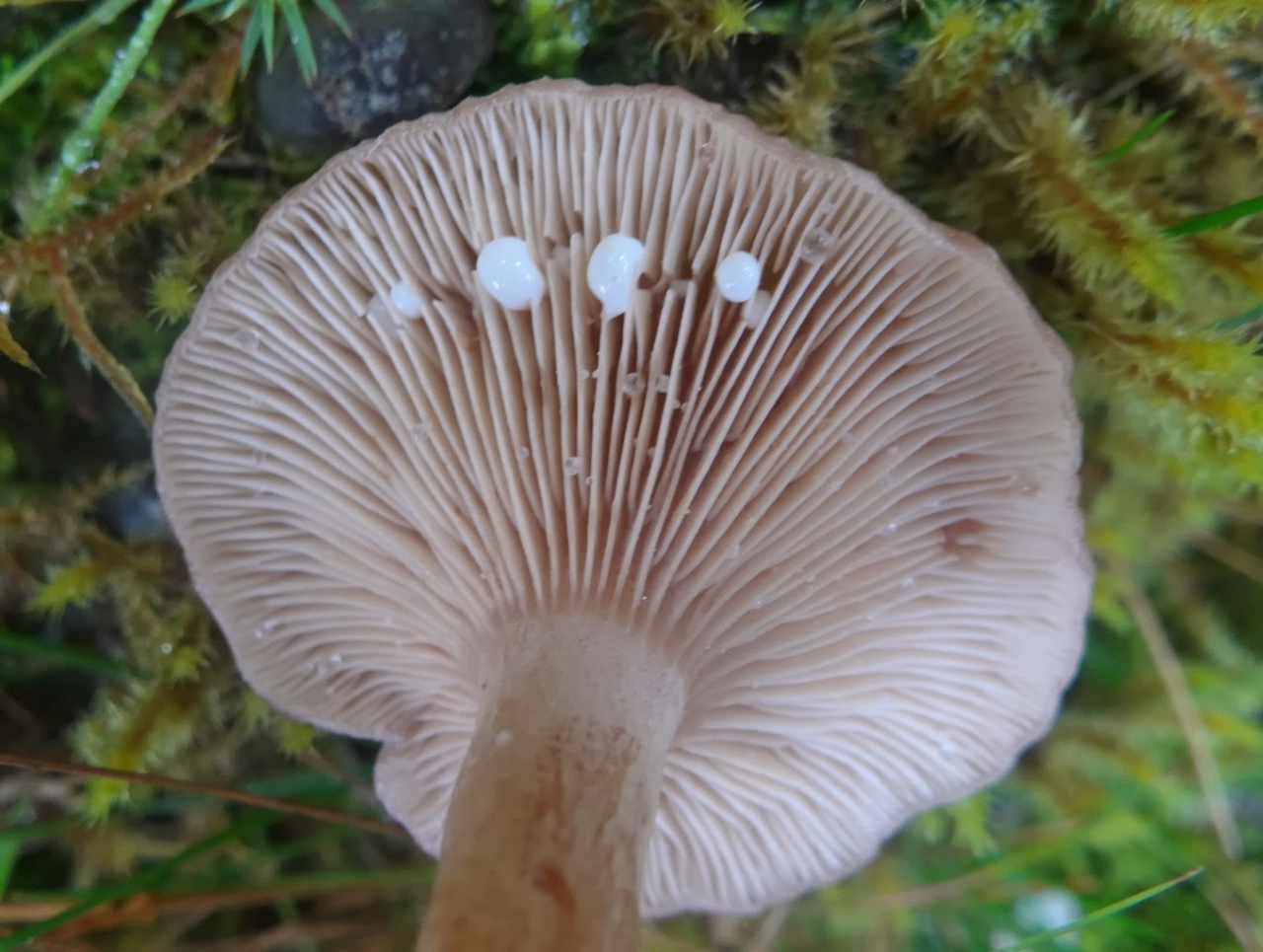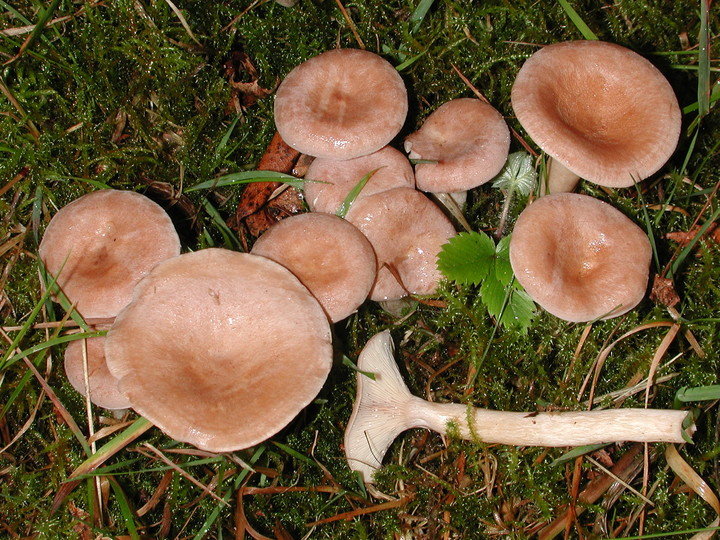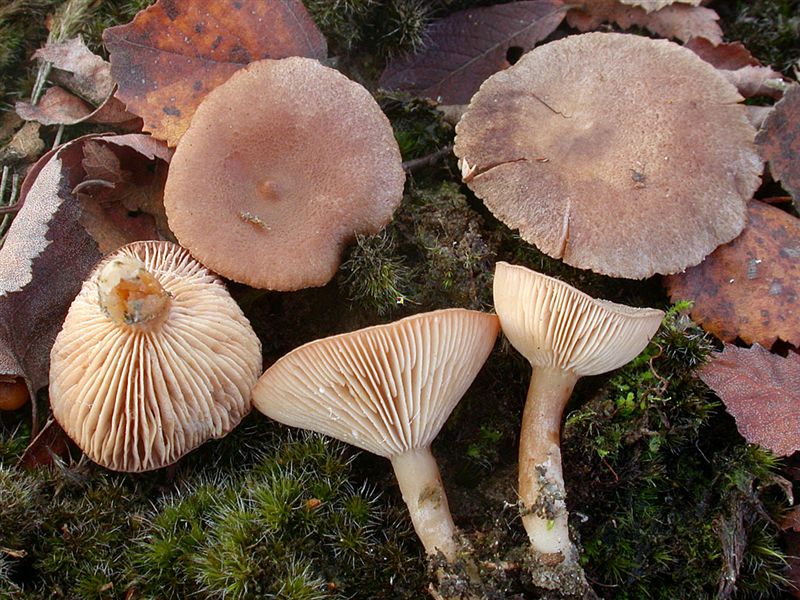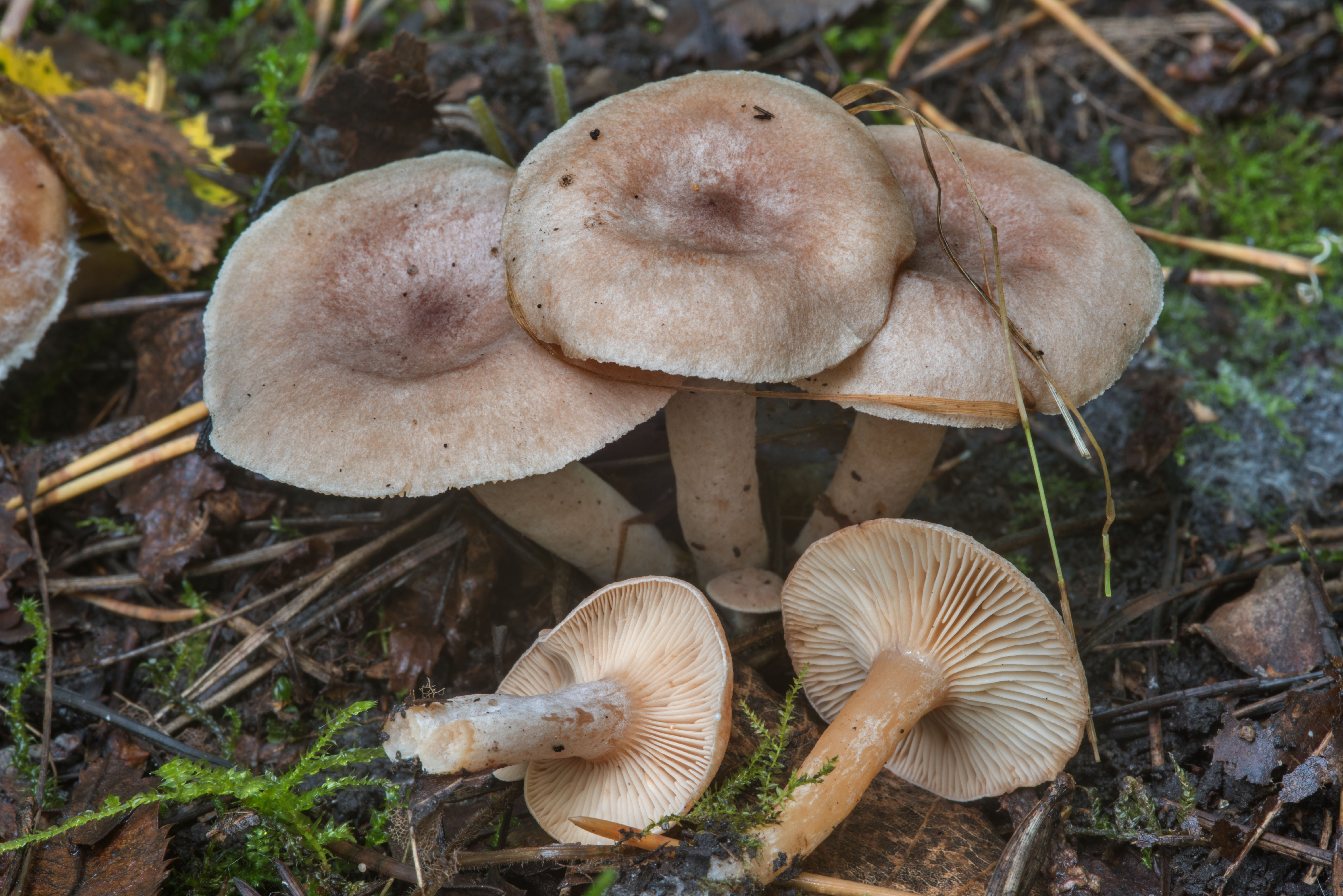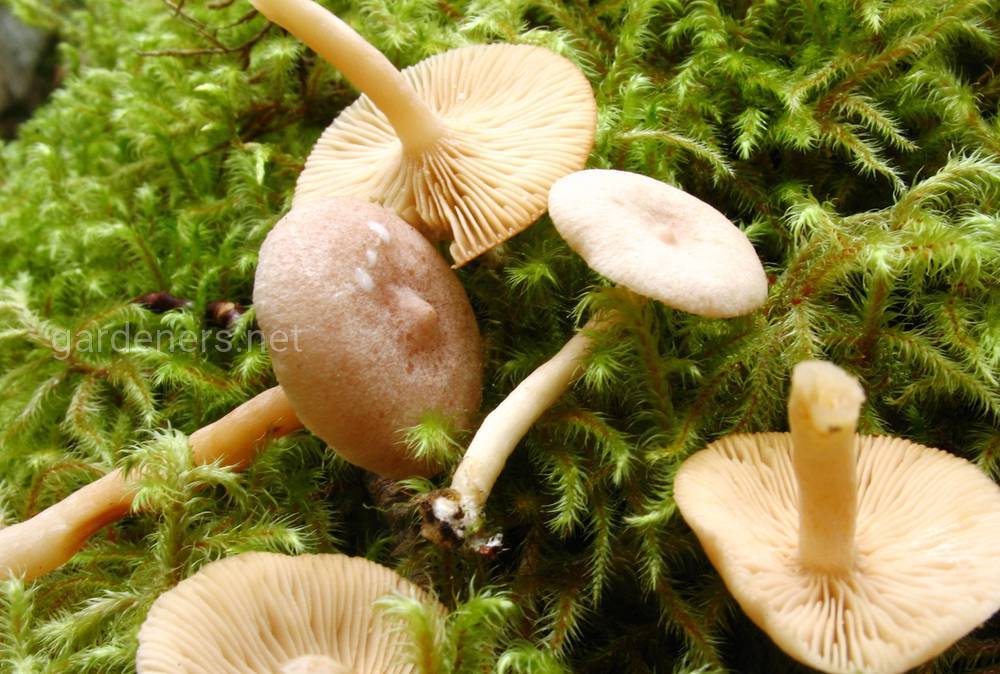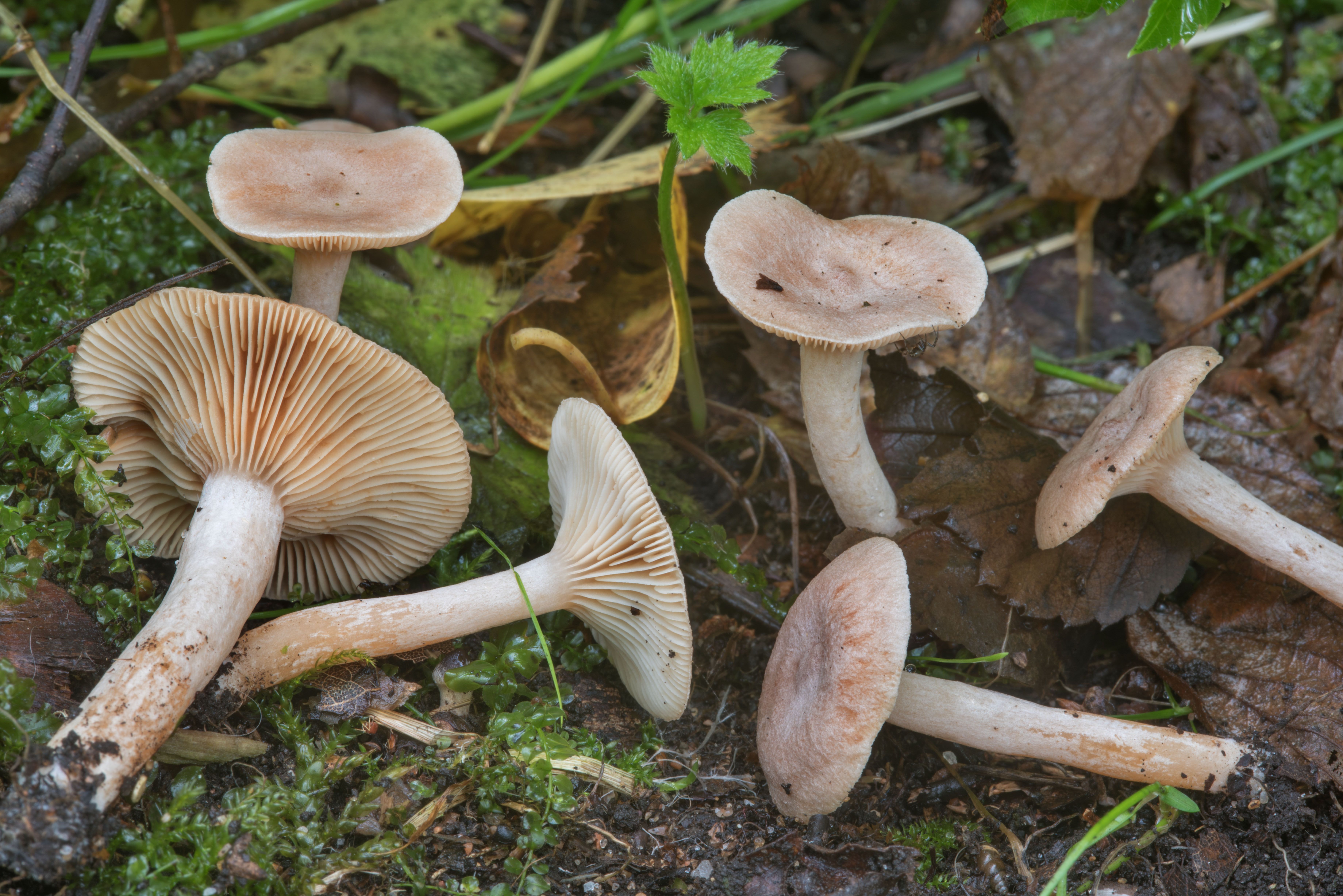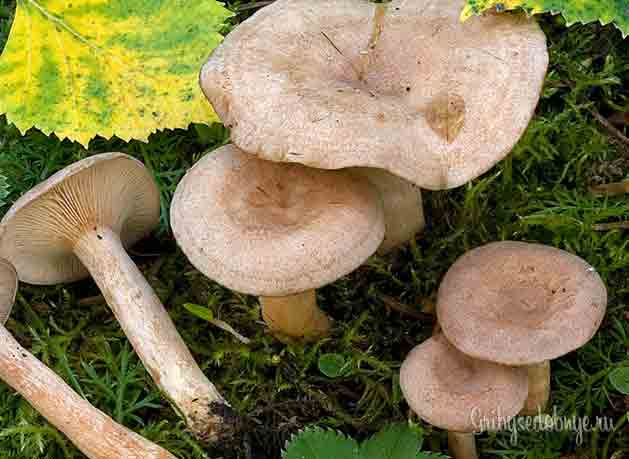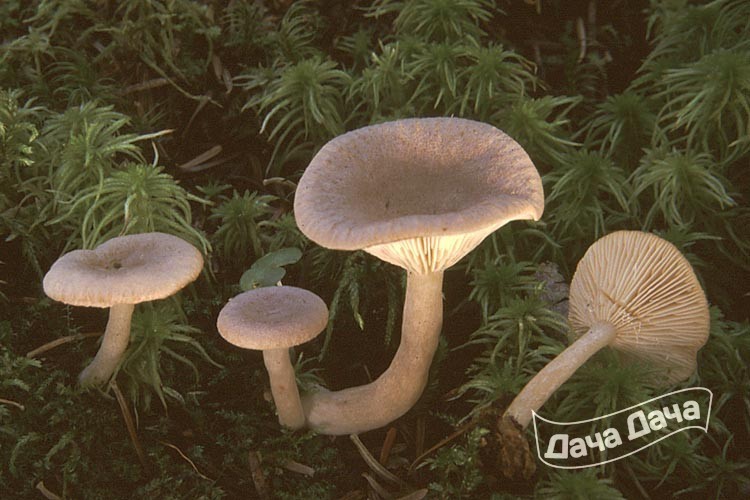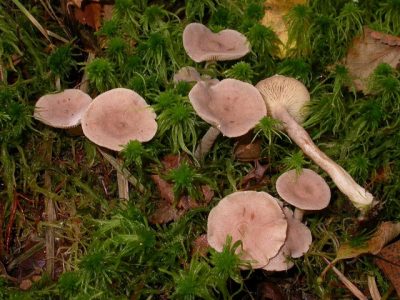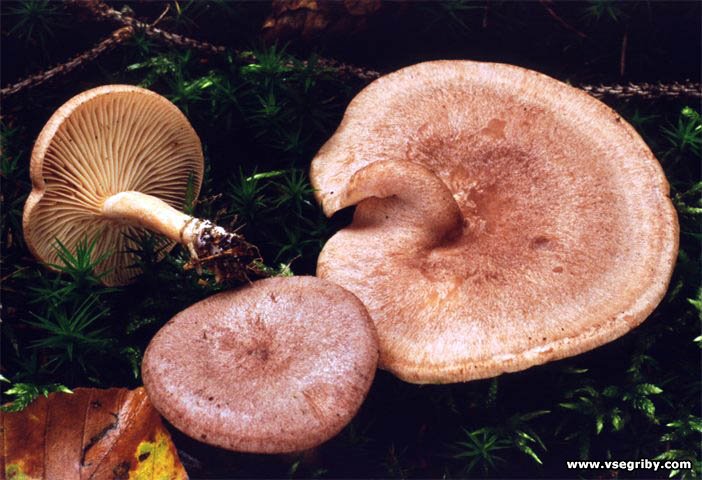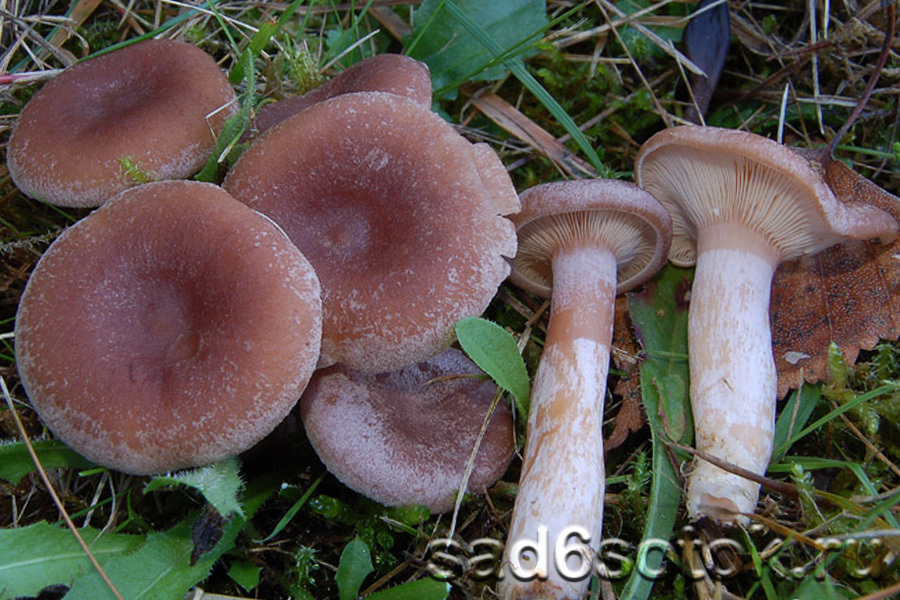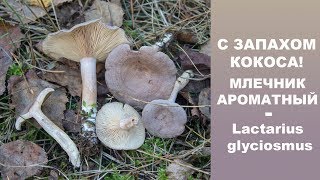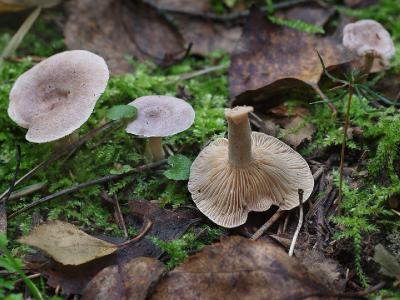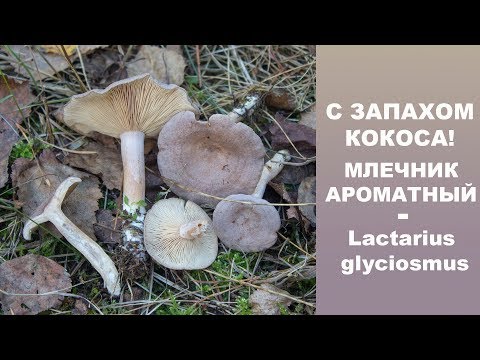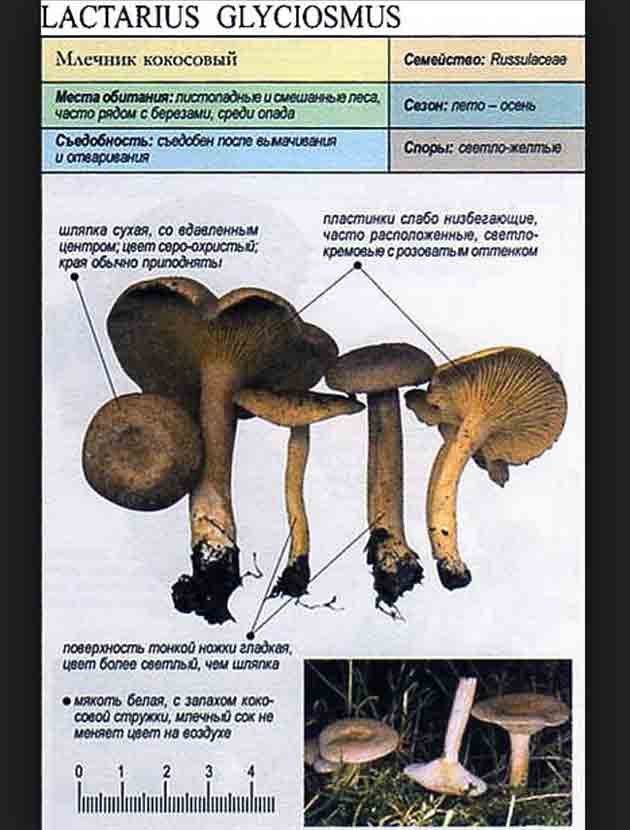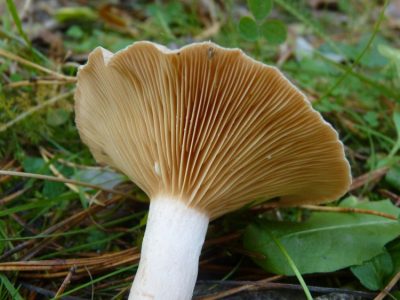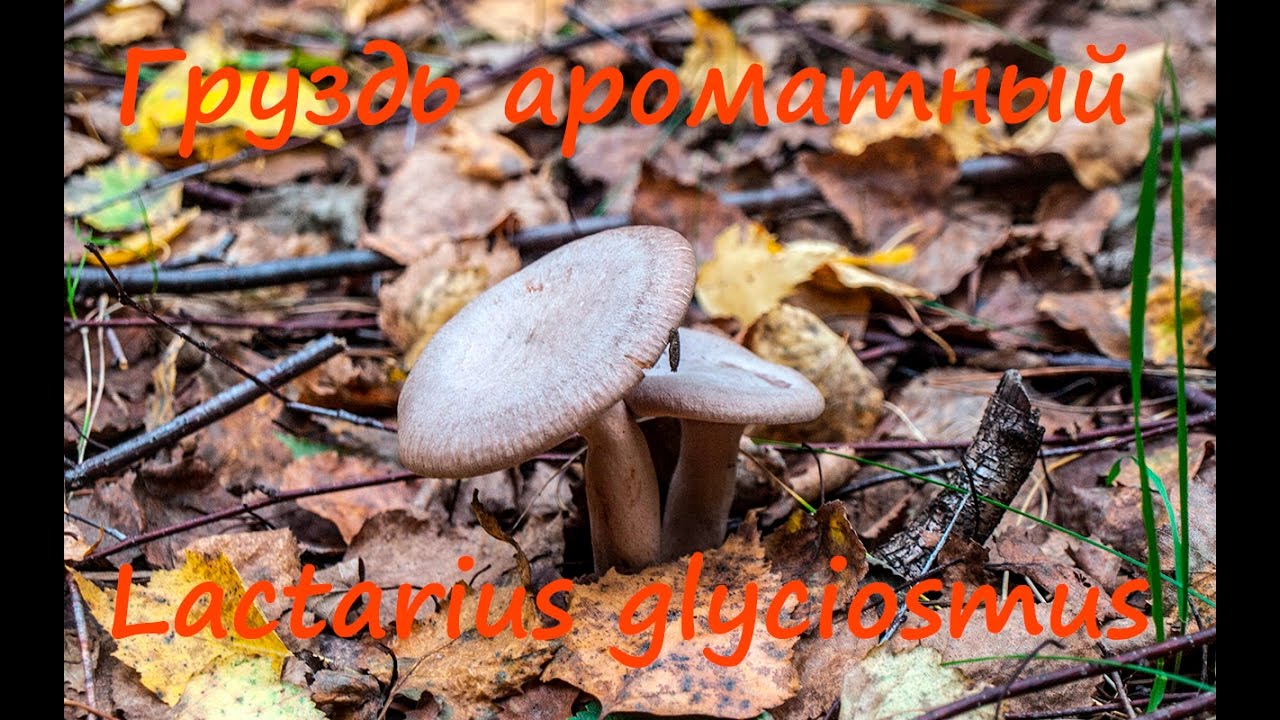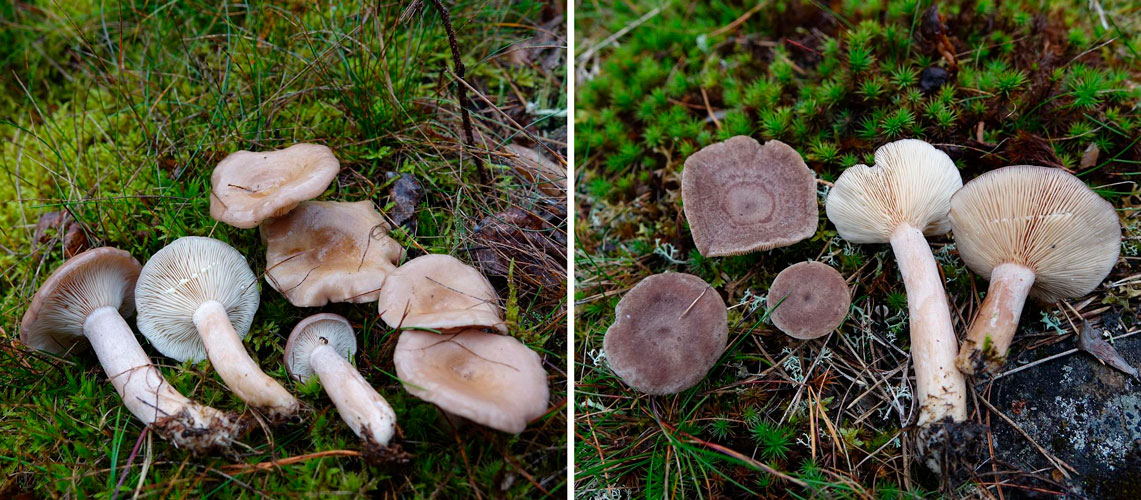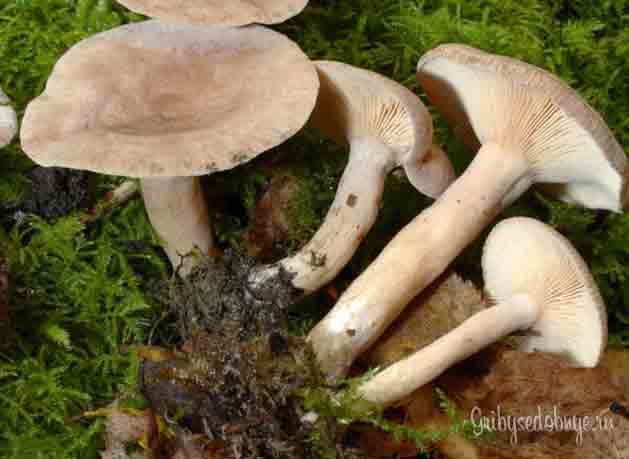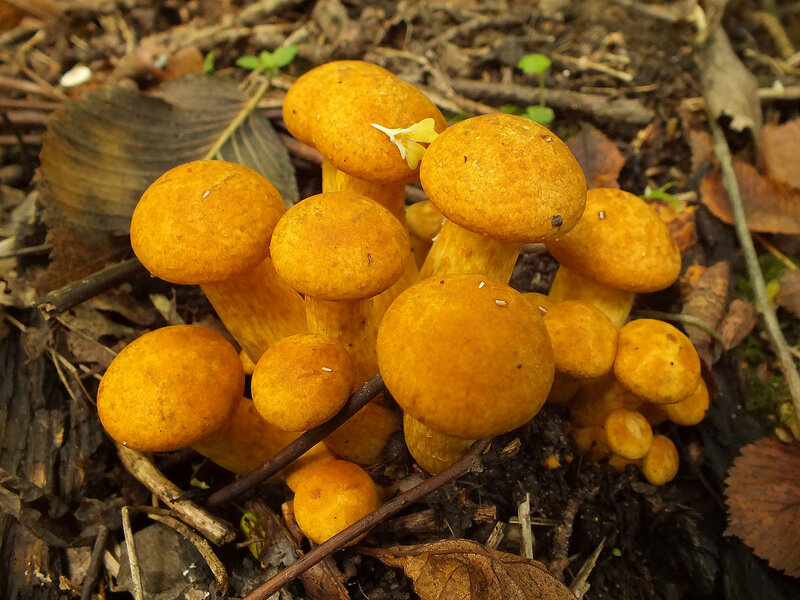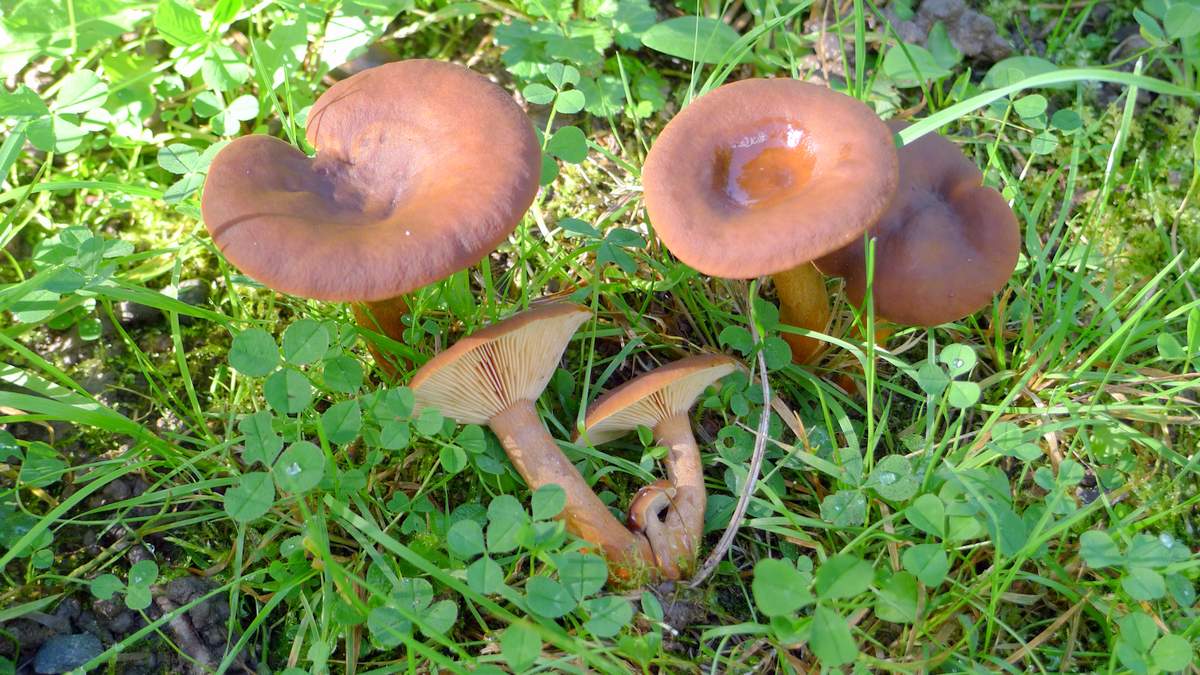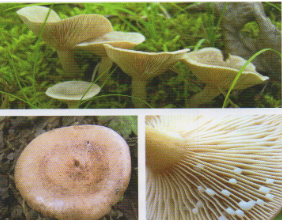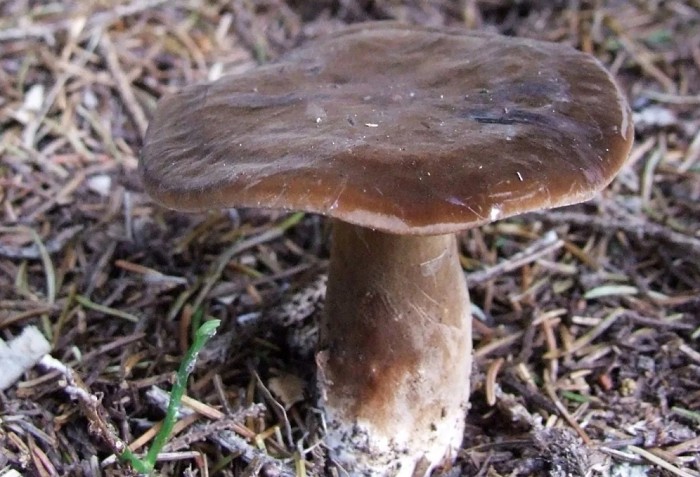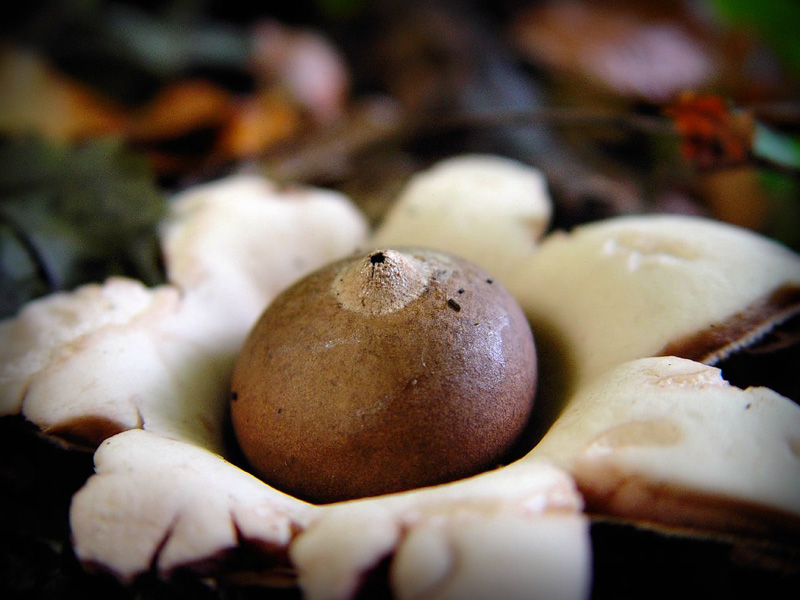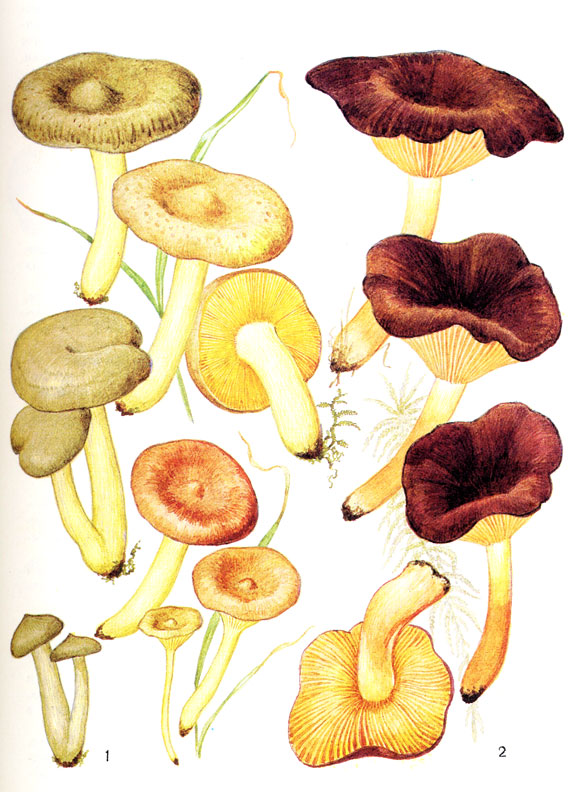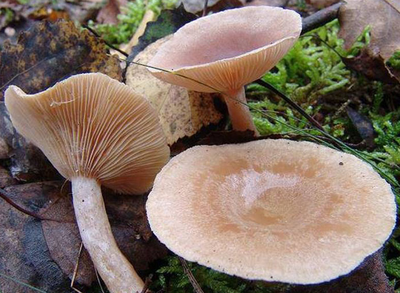Millers are zoneless and pale
Zoneless milky (Lactarius azonites) has a cap 3–8 cm in diameter. The cap is dry, matte. Gray, nut-gray in color, covered with small heels of a lighter shade. Ivory plates. The pulp and plates, if damaged, take on a reddish-coral hue. Milky juice is white, weakly sharp.
The leg is 3–8 cm high, up to 1.5 cm in diameter, white, creamy at maturity, filled at first, later hollow, fragile.
Spore powder. Whitish.
Habitat. In deciduous forests, prefers oak.
Season. Summer autumn.
Similarity. It is similar to some other milkers, but differs in a gray cap without zones and a coral color of damaged pulp.
Use. Most likely inedible, in some Western sources it is characterized as suspicious.
The pallid miller (Lactarius pallidus) is a rare conditionally edible lamellar mushroom that grows singly or in small groups from mid-July to late August in deciduous and mixed forests. Differs in stable yield, not depending on weather conditions.
Its surface, as a rule, is smooth, but it can also be cracked, shiny, covered with a thin layer of sticky mucus, painted in a yellowish or fawn color. The spore-bearing plates are narrow, the same color as the cap. The leg is round, straight, even or thinner at the base, hollow inside, about 9 cm high with a diameter of only about 1.5 cm.The pulp is thick, fleshy, firm, white or creamy, with a pleasant mushroom aroma and bitter, but not pungent taste. Gives off a large amount of white milky juice, which does not change its color on contact with air.
Pale milky belongs to the third category of mushrooms. Soaking in cold water or boiling takes away the bitterness from the pulp, so the mushrooms can be used for pickling.
Spore powder. Light ocher.
Habitat. In deciduous forests, he prefers beech and oak.
Season. Summer autumn.
Similarity. With a load of pepper (L. piperatus), but it has a very caustic milky juice that turns gray-green in the air.
Use. The mushroom can be salted.
This video demonstrates lactariuses in their natural habitat:
Poisonous and inedible species of milky mushroom
Sticky Miller (Lactárius blénnius)
Inedible mushroom.
The diameter of the cap is 4-10 cm, the shape is convex, later extended, the edge is curved. The surface of the cap is shiny, sticky, gray-green in color with dark concentric zones. Leg 4-6 cm long, 2.5 cm in diameter, light. The pulp is white, odorless, the taste is sharp, peppery. Milky juice is thick, white.
Mycorrhiza forms with deciduous trees, grows in summer and autumn in small groups in deciduous forests of Europe and Asia.
Gray-pink Miller (Lactárius hélvus)
Inedible mushroom.
The cap is 6-12 cm in diameter, the shape is flat, later funnel-shaped, the edge is curled up. The color is pinkish brown. The leg is 9 cm high, 1.5-2 cm thick, cylindrical in shape, the color matches the cap. The pulp is light yellow in color. The smell is strong, spicy, unpleasant. The taste is bitter. Milky sap is watery white.
Grows in coniferous forests in the northern temperate zone. The fruiting season is from July to September.
Liver miller (Lactárius hepáticus)
Inedible mushroom.
Hat 3-6 cm in diameter, liver-brown color, smooth surface. The leg is 3-6 cm in height, 0.6-1 cm in thickness, cylindrical in shape, color like a cap. The flesh is thin, creamy or light brown in color, acrid.
Forms mycorrhiza with pine.
Dark Miller (Lactárius obscurátus)
Inedible mushroom.
The cap is 1.5-3 cm in diameter, in a young fungus it is flat, later goblet, the edge is wrinkled, the surface is matte, the color is ocher-brown. The leg is 0.5 cm in diameter, 2-3 cm in height, cylindrical in shape, color like a cap.The pulp is brittle, brown in color. Milky juice is white.
Grows in mixed and deciduous forests, from mid-July to September.
Resinous black miller (Lactárius pícinus)
Inedible mushroom.
The hat is 4-10 cm in diameter, the shape is convex, later spread out. The surface is velvety, brownish brown. The leg is 3-6 cm high, 1-1.5 cm thick, cylindrical in shape, tapering towards the base. The pulp is white, dense, the smell is weak, fruity, the taste is sharp, peppery, turns pink in the air. The milky juice is thick, white, turns red in air.
Grows in small groups or singly in coniferous and mixed forests. The season starts in mid-August and lasts until the end of September.
Orange Miller (Lactárius pornínsis)
Inedible mushroom.
The hat is 3-8 cm in diameter, the shape is convex. Orange color, smooth surface.
The leg is 3-6 cm long, 0.8-1.5 cm in diameter, cylindrical in shape, tapering towards the base, in a young mushroom it is solid, later hollow, the color coincides with the cap. The pulp is dense, fibrous, the smell is orange. Milky juice is thick, sticky, white.
Grows in deciduous forests, in small groups, in summer and autumn.
Wet Miller (Lactárius úvidus)
Inedible mushroom.
The diameter of the cap is 4-8 cm; in a young mushroom, the shape is convex, later prostrate. The edge is bent. The color is grayish-steel with a violet tinge, the surface is smooth and damp. The pulp is odorless, the taste is pungent, white or yellowish, turns purple on the cut. Milky juice is abundant, white, turns purple in air. The leg is 4-7 cm high, 1-2 cm thick, strong, cylindrical.
A rare mushroom that grows in damp deciduous and mixed forests, from early August to late September.
Related species of aromatic lactarius
The zonal milky is another conditionally edible milky. His hat is very fleshy, rather large. Its shape is funnel-shaped at first, and later flat. The surface of the cap is dry, ocher or cream color. The stem is central, rigid, dense, can be ocher, cream or white. The pulp is tough, the taste is burning, white in color. White milky juice will stand out on the cut.
Zoned milkmen grow almost everywhere, mainly giving preference to forests in which there are beeches and oaks. They form mycorrhiza with oaks and birches. They settle in large groups and singly.

Wet miller is also a conditionally edible mushroom. The shape of the cap is at first convex, and over time it changes to an outstretched one. The hat is smooth and sticky to the touch. The color of the cap varies from gray to grayish-purple. The leg is strong, cylindrical in shape, its surface is sticky. The pulp is tender, spongy, and has a pungent taste. The milky juice secreted from the pulp is very abundant. At first it is white, but in the air it takes on a purple hue.
Wet millers are a rare species of mushrooms. These mushrooms settle in small groups or singly. Places of their growth are deciduous and mixed forests. Wet millers prefer moist, mossy places. They bear fruit from August to September.

Definitioner
- Basidia (Basidia)
-
Lat. Basidia. A specialized structure of sexual reproduction in fungi, inherent only in Basidiomycetes. Basidia are terminal (end) elements of hyphae of various shapes and sizes, on which spores develop exogenously (outside).
Basidia are diverse in structure and method of attachment to hyphae.
According to the position relative to the axis of the hypha, to which they are attached, three types of basidia are distinguished:
Apical basidia are formed from the terminal cell of the hypha and are located parallel to its axis.
Pleurobasidia are formed from lateral processes and are located perpendicular to the axis of the hypha, which continues to grow and can form new processes with basidia.
Subasidia are formed from a lateral process, turned perpendicular to the axis of the hypha, which, after the formation of one basidium, stops its growth.
Based on morphology:
Holobasidia - unicellular basidia, not divided by septa (see Fig. A, D.).
Phragmobasidia are divided by transverse or vertical septa, usually into four cells (see Fig. B, C).
By type of development:
Heterobasidia consists of two parts - hypobasidia and epibasidia developing from it, with or without partitions (see Fig. C, B) (see Fig. D).
Homobasidia is not divided into hypo- and epibasidia and in all cases is considered holobasidia (Fig. A).
Basidia is the place of karyogamy, meiosis and the formation of basidiospores. Homobasidia, as a rule, is not functionally divided, and meiosis follows karyogamy in it. However, basidia can be divided into probasidia - the site of karyogamy and metabasidia - the site of meiosis. Probasidium is often a dormant spore, for example in rust fungi. In such cases, probazidia grows with metabasidia, in which meiosis occurs and on which basidiospores are formed (see Fig. E).
See Karyogamy, Meiosis, Gifa.
- Pileipellis
-
Lat. Pileipellis, skin - differentiated surface layer of the cap of agaricoid basidiomycetes. The structure of the skin in most cases differs from the inner flesh of the cap and may have a different structure. The structural features of pileipellis are often used as diagnostic features in descriptions of fungi species.
According to their structure, they are divided into four main types: cutis, trichoderma, hymeniderma and epithelium.
See Agaricoid fungi, Basidiomycete, Cutis, Trichoderma, Gimeniderm, Epithelium.
- Anastomoses (Anastomosis)
-
1) Fusion of cells of branched hyphae or germ tubes of germinating spores;
2) Connecting the plates of the fruiting bodies of the mushrooms with jumpers.
Evaluation of the palatability of a fragrant load
Aromatic milk-keepers do not enjoy special attention among mushroom pickers, but these are edible mushrooms. Few people collect fragrant milk mushrooms, there is no need to do this, since in the mushroom season there are a huge number of more famous and tasty mushrooms
But with a poor mushroom harvest, experienced mushroom pickers do not bypass these small mushrooms. And foreigners consider fragrant milkmen to be inedible.
The aromatic milk mushroom belongs to the 3rd category. It has no special taste properties. These mushrooms can be salted, but before that it is recommended to boil them for 15 minutes. This time is quite enough to eliminate the strong smell of pulp.

Brownish milky
- The mushroom is classified as conditionally edible. The top reaches a maximum of 12 cm in diameter, but there are specimens of 5-10 cm on average. The hat is colored with a chocolate shade, it quickly breaks. The edges are bent, the top itself becomes depressed over time. Feels like velvet.
- The base can be up to 11 cm long. It is colored brown, beige or white. The format is cylindrical. The plates on the inside of the hat are closely spaced, colored with ocher or pink pigment.
- The soft part breaks quickly, it is very fragile and white. If you make a cut, then when weathered, the pulp will change and become pinkish in this area. Smells delicious berries, no bitterness. It is necessary to search for copies in Europe. They bear fruit from mid-summer to early autumn.
- This mushroom is considered conditionally edible, as it is eaten more often than other varieties. The specimens are salted and dried. However, such mushrooms are consumed in the vastness of our homeland, in European countries they are not eaten.
Description of the fragrant load
At first, the cap of the aromatic load is slightly convex, but later it straightens and then becomes concave. Its diameter does not exceed 7 centimeters. A small tubercle is visible in the central part of the cap. The surface of the cap is uneven, gray-yellow, gray-pink or gray-lilac. Concentric narrow circles are visible on the surface of the head. When it rains, the cap becomes more sticky and shines.
There are plates under the head. They are narrow and frequent.At first, the color of the plates is yellowish, and in old mushrooms it turns brown.
The pulp of a fragrant milkman is very fragile. It is because of the fragility of the fruit bodies that many mushroom pickers do not collect these mushrooms. The color of the pulp is white; it does not change when damaged. The pulp gives off a strong smell of fresh hay. If the pulp is damaged, milky juice is abundantly secreted. The color of the milky juice is white.

The leg of the aromatic load is thin, it narrows noticeably downward. The leg is fragile in structure, inside it is hollow. The color of the leg is lighter than the cap.
External description of the mushroom
The fruiting body of a wet lactarius consists of a stem and a cap. The height of the leg is 4-7 cm, and the thickness is 1-2 cm. Its shape is cylindrical, slightly widening at the base. The structure at the foot is strong and durable, and the surface is sticky.
It is very rare to meet this type of mushroom, a distinctive feature can be called the color of the cap, which varies from grayish to gray-violet. Its diameter is 4-8 cm, in young mushrooms it has a convex shape, which becomes prostrate over time. On the surface of the cap of old, mature mushrooms, there is a depression, as well as a wide flattened tubercle. The edges of the cap are bordered with small villi and bent. From above, the cap is covered with a grayish-steel skin, with a slight shade of purple. It is wet, sticky and smooth to the touch. These characteristics are especially common in humid climates. A vaguely expressed zoning sometimes appears on the surface of the cap.
The hymenophore of the fungus is represented by plates containing white spore powder. The plates themselves have a small width, are often located, slightly descend along the stem, initially have a white color, but turn yellow over time. When pressed and damaged, purple spots appear on the plates. The milky juice of the fungus is characterized by a white color, but under the influence of air it acquires a purple hue, its release is very abundant.
The structure of the mushroom pulp is spongy and tender. It does not have a characteristic and pungent smell, but the taste of the pulp is distinguished by its sharpness. In color, the pulp of the wet lactarius is white or slightly yellowish; in case of damage to the structure of the fruiting body, a shade of purple is mixed with the main color.
Useful properties, medical applications and restrictions on use
Milk mushrooms have long been used in folk medicine for the treatment of purulent wounds, kidney diseases and other diseases. Most of the species have anti-tumor and antibacterial effects. The fruit contains vitamins that have a beneficial effect on the nervous system and prevent the development of sclerosis.
Lactose
Medicines made on the basis of milk mushrooms help cope with kidney stones. The blue milk mushroom contains a natural antibiotic that has a detrimental effect on staphylococci. In some fruits, scientists have discovered lactarioviolin, an antibiotic that helps to destroy the pathogens of tuberculosis.
Most of the mushrooms of this genus are conditionally edible fruits, so they need to be heat treated before eating. You cannot harvest near highways, factories and plants, it is better to do this in ecologically clean areas. It is not advised to eat these fruits for gastrointestinal diseases, pregnancy and breastfeeding.
Recipes and cooking features
Mushrooms of this kind can be fried, boiled and pickled, but in this form their taste is muted. Salty and fermented milkers are characterized by good taste. Ryzhiks do not require prolonged soaking, but bitters, milk mushrooms and waves should be soaked for a while in cold water.
Here are some delicious recipes:
- If the basket is filled with mushrooms, this is a great reason to please loved ones with fried mushrooms. The crop is washed and cleaned from forest debris. Each copy is cut into 5-7 pieces and laid out in a preheated pan with sunflower oil.
Fried mushrooms The fire should be medium so that the water from the mushroom mass evaporates faster. When the water has boiled off, reduce the heat and fry for about 15 minutes. At this time, you can add finely chopped onion, salt and fry for about another five minutes.
- To prepare delicious Korean mushrooms, you will need the following ingredients:
- milkmen (any bitter mushrooms);
sugar;
soy sauce;
table vinegar;
fresh garlic;
hot pepper;
ground coriander.
Millers in Korean
The fruits are pre-boiled 2-3 times for 30 minutes, each time changing the water. It is desirable that a slightly bitter taste remains in them, which will give the dish a special piquancy. Boiled fruits are seasoned with soy sauce, sugar and a little vinegar are added. The resulting mass is thoroughly mixed with the addition of the necessary spices. The finished dish should be allowed to brew for several hours in the refrigerator.
Harm and contraindications of milkmen
You must not pick and eat mushrooms that grow near highways, garbage cans and enterprises that pollute nature. The fact is that any mushrooms absorb harmful substances and heavy metals. Accordingly, they can be harmful to health.
Conditionally edible milkmen cannot be eaten without preliminary processing - soaking, boiling
This is done to remove the bitter milky juice, which, if it enters the human digestive system, can cause eating disorders.
All mushrooms should be eaten in small quantities, and for diseases such as pancreatitis, stomach and duodenal ulcers, gastritis, liver failure, cirrhosis of the liver, hepatitis, they should be abandoned altogether.
Lacticians are eaten with caution during pregnancy and lactation. Mushrooms are contraindicated for small children.
Salted mushrooms should not be eaten with hypertension and kidney disease, as this threatens to disrupt the water-salt balance.
The gingerbreads are real.


